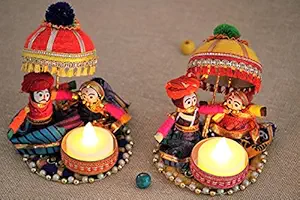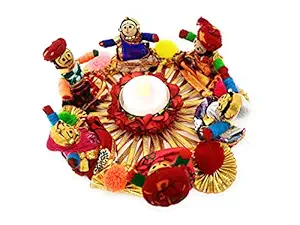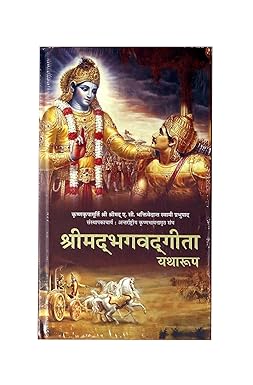नवरात्रि: दिव्य स्त्री शक्ति का उत्सव
नवरात्रि भारत में मनाए जाने वाले सबसे जीवंत और महत्वपूर्ण त्योहारों में से एक है। नौ रातों और दस दिनों तक चलने वाली यह त्योहार दिव्य स्त्री ऊर्जा का सम्मान करती है और अच्छाई की बुराई पर जीत का प्रतीक है। आइए नवरात्रि के सार, इसकी परंपराओं और आध्यात्मिक महत्व को समझें।
नवरात्रि क्या है?
"नवरात्रि" शब्द संस्कृत के "नव" (नौ) और "रात्रि" (रात) से बना है। यह त्योहार माँ दुर्गा के नौ रूपों की पूजा के लिए समर्पित है, जिनमें से प्रत्येक जीवन और आध्यात्मिकता के विभिन्न पहलुओं का प्रतिनिधित्व करता है। नवरात्रि साल में दो बार मनाई जाती है—वसंत नवरात्रि (चैत्र) और शरद नवरात्रि (शरद), जिसमें बादली अधिक व्यापक रूप से मनाई जाती है।
नवरात्रि का महत्व
नवरात्रि अच्छाई की बुराई पर जीत का प्रतीक है। यह देवी दुर्गा की भैंस दानव महिषासुर पर विजय प्राप्ति का स्मरण कराता है, जो नकारात्मकता के विनाश और धर्म की बहाली को दर्शाता है। यह विजय प्रकाश और अंधकार, ज्ञान और अज्ञानता, और पुण्य और पाप के बीच की शाश्वत लड़ाई का प्रतीक है।
उत्सव और परंपराएँ
नवरात्रि के दौरान, भक्त विभिन्न अनुष्ठानों में संलग्न होते हैं, जिसमें उपवास, प्रार्थना, नृत्य, और संगीत शामिल हैं। प्रत्येक दिन देवी के एक अलग रूप को समर्पित होता है, और उन्हें सम्मानित करने के लिए विशिष्ट गतिविधियाँ की जाती हैं:
- शैलपुत्री
- ब्रह्मचारिणी
- चंद्रघंटा
- कुम्हांडा
- स्कंदमाता
- कात्यायनी
- कालरात्रि
- महागौरी
- सिद्धिदात्री
नवरात्रि के दौरान सबसे लोकप्रिय परंपराओं में गरबा और दांडिया रास शामिल हैं, जो देवी की आनन्दमयी पूजा का प्रतीकात्मक नृत्य हैं।
आध्यात्मिक महत्व
नवरात्रि केवल बाहरी उत्सवों का त्योहार नहीं है; यह एक गहरा आध्यात्मिक यात्रा है। यह आत्मचिंतन, आंतरिक शुद्धिकरण, और सकारात्मक गुणों के विकास को प्रोत्साहित करता है। नौ रातें अज्ञानता से ज्ञान की ओर प्रगति का प्रतिनिधित्व करती हैं, व्यक्तियों को अपने अंदर के दानवों पर विजय प्राप्त करने और पुण्य को अपनाने के लिए प्रेरित करती हैं।
निष्कर्ष
नवरात्रि आनंद, भक्ति, और परिवर्तन का समय है। यह समुदायों को एकजुट करती है, सांस्कृतिक धरोहर को बढ़ावा देती है, और व्यक्तिगत विकास को प्रेरित करती है। जब हम दिव्य स्त्री की पूजा करते हैं, तो हम सभी देवी दुर्गा के गुण—शक्ति, साहस, करुणा, और ज्ञान—को अपनाने का प्रयास करें।
Introduction
Overview of Navratri
Navratri is a nine-day Hindu festival celebrating the divine feminine energy and devotion to Goddess Durga.
Significance of the Festival
This festival symbolizes the victory of good over evil and encourages spiritual reflection and devotion.
Timing and Duration
Navratri is celebrated over nine nights typically in the month of September or October according to the Hindu calendar.
Global Celebrations
Navratri is observed across India and worldwide with cultural performances prayers and community gatherings.
Cultural Importance
The festival preserves rich traditions of dance music and rituals that strengthen cultural identity.
Daily Rituals
First Day
The first day of Navratri involves invoking Goddess Shailputri with prayers offerings and traditional songs.
Second Day
Devotees worship Goddess Brahmacharini with fasting chanting and participation in Garba dances.
Third Day
The third day is dedicated to Goddess Chandraghanta celebrated with devotional singing and prayers at home and temples.
Fourth Day
On this day Goddess Kushmanda is worshipped and special rituals are performed to seek health and prosperity.
Fifth Day
Devotees honor Goddess Skandamata with prayers floral offerings and community gatherings for spiritual enrichment.
Dance and Music
Garba
Garba dance is performed in circular movements with clapping and rhythmic steps to the beats of traditional instruments.
Dandiya Raas
Dandiya Raas involves using colorful sticks to perform synchronized steps in groups symbolizing joy and devotion.
Traditional Songs
Devotional Garba and Dandiya songs narrate stories of Goddess Durga and inspire collective participation.
Musical Instruments
Dhol tabla manjira and harmonium are commonly used to accompany dances enhancing the festive atmosphere.
Community Participation
People of all ages participate forming circles and pairs creating vibrant and energetic celebrations.
Spiritual Practices
Fasting
Fasting is observed in various forms to purify the body and mind and express devotion during Navratri.
Prayer and Meditation
Devotees perform daily prayers and meditate to seek the blessings of Goddess Durga for strength and prosperity.
Temple Visits
Visiting temples during Navratri is a common practice to participate in rituals and witness special ceremonies.
Offerings
Flowers fruits sweets and other traditional items are offered to the Goddess as a symbol of devotion.
Significance of Colors
Each day of Navratri is associated with a specific color representing different aspects of Goddess Durga and her energy.
Conclusion
Social Bonding
Navratri fosters community bonding bringing people together in celebration dance and prayer.
Preservation of Culture
Through music dance and rituals Navratri helps preserve and promote traditional Indian culture.
Youth Participation
Young generations learn Garba and Dandiya ensuring the continuation of cultural heritage.
Global Recognition
Navratri is now celebrated internationally promoting awareness of Indian traditions and devotional practices.
Spiritual Fulfillment
Devotees experience spiritual growth joy and fulfillment through participation in the Navratri festival.
Navratri is a nine-day Hindu festival celebrating the divine feminine energy and devotion to Goddess Durga.
This festival symbolizes the victory of good over evil and encourages spiritual reflection and devotion.
Navratri is celebrated over nine nights typically in the month of September or October according to the Hindu calendar.
Navratri is observed across India and worldwide with cultural performances prayers and community gatherings.
The festival preserves rich traditions of dance music and rituals that strengthen cultural identity.
The first day of Navratri involves invoking Goddess Shailputri with prayers offerings and traditional songs.
Devotees worship Goddess Brahmacharini with fasting chanting and participation in Garba dances.
The third day is dedicated to Goddess Chandraghanta celebrated with devotional singing and prayers at home and temples.
On this day Goddess Kushmanda is worshipped and special rituals are performed to seek health and prosperity.
Devotees honor Goddess Skandamata with prayers floral offerings and community gatherings for spiritual enrichment.
Garba dance is performed in circular movements with clapping and rhythmic steps to the beats of traditional instruments.
Dandiya Raas involves using colorful sticks to perform synchronized steps in groups symbolizing joy and devotion.
Devotional Garba and Dandiya songs narrate stories of Goddess Durga and inspire collective participation.
Dhol tabla manjira and harmonium are commonly used to accompany dances enhancing the festive atmosphere.
People of all ages participate forming circles and pairs creating vibrant and energetic celebrations.
Fasting is observed in various forms to purify the body and mind and express devotion during Navratri.
Devotees perform daily prayers and meditate to seek the blessings of Goddess Durga for strength and prosperity.
Visiting temples during Navratri is a common practice to participate in rituals and witness special ceremonies.
Flowers fruits sweets and other traditional items are offered to the Goddess as a symbol of devotion.
Each day of Navratri is associated with a specific color representing different aspects of Goddess Durga and her energy.
Navratri fosters community bonding bringing people together in celebration dance and prayer.
Through music dance and rituals Navratri helps preserve and promote traditional Indian culture.
Young generations learn Garba and Dandiya ensuring the continuation of cultural heritage.
Navratri is now celebrated internationally promoting awareness of Indian traditions and devotional practices.
Devotees experience spiritual growth joy and fulfillment through participation in the Navratri festival.


